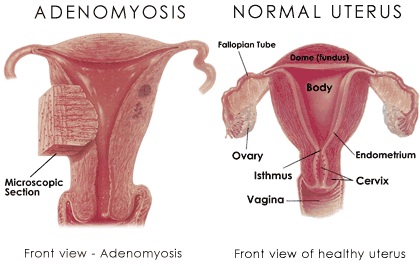Adenomyosis Causes, Symptoms, Diagnosis and Treatment

What Is Adenomyosis?
Adenomyosis is a medical disease characterized by the presence of ectopic glandular tissue found in muscle.
It is a condition in which the inner lining of the uterus (the endometrium) breaks through the muscle wall of the uterus.
Causes Of Adenomyosis:
Cause of Adenomyosis is yet unknown. However, different possible theories have been proposed by experts. They include the following:
- Invasive tissue growth
Uterine incisions made during an operation such as a cesarean section (C-section) may promote the direct invasion of the endometrial cells into the wall of the uterus.
- Developmental origins
Experts speculate that adenomyosis originates within the uterine muscle from endometrial tissue deposited there when the uterus first formed in the fetus.
- Uterine inflammation related to childbirth.
An inflammation of the uterine lining during the postpartum period might cause a break in the normal boundary of cells that line the uterus.
- Stem cell origins
A recent theory proposes that bone marrow stem cells may invade the uterine muscle, causing adenomyosis.
Symptoms Of Adenomyosis:
Sign and symptoms of adenomyosis may include the following:
- Intense debilitating pain all the time
- Acute & increasing pain at menstruation and ovulation
- Strong ‘contraction’ feel of uterus
- Abdominal cramps
- A ‘bearing’ down feeling
- Pressure on bladder
- Dragging sensation down thighs and legs
- Heavy bleeding and flooding
- Large blood clots
- Prolonged bleeding i.e.; up to 8–14 days
Complications From Adenomyosis:
A complication which may arise due to adenomyosis is chronic anemia. Anemia is known to cause fatigue and other health problems. Moreover, adenomyosis disrupts one’s lifestyle with recurring pain leading to depression, irritability, anxiety, anger and feelings of helplessness.
Diagnosis Of Adenomyosis:
Adenomyosis can be diagnosed through the following tests and exam:
- A pelvic exam that reveals an enlarged, tender uterus
- Ultrasound imaging of the uterus
- Magnetic resonance imaging (MRI) of the uterus
Treatment Of Adenomyosis:
Adenomyosis usually goes away after menopause. However, treatment is available
The following treatment can help in managing adenomyosis:
- Anti-inflammatory drugs
- Hormone medications
- Hysterectomy
Life style and home remedies may also help in easing the pain. These include:
- Soak in a warm bath.
- Use a heating pad on your abdomen.
By : Natural Health News




